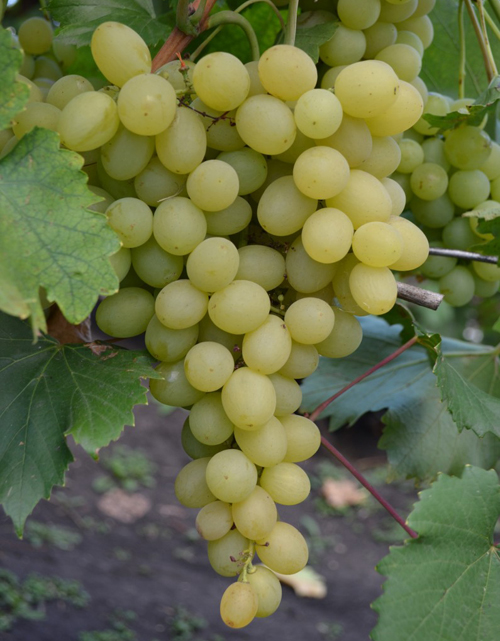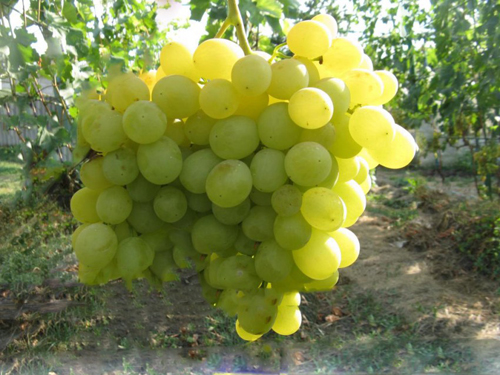Grape variety Delight
Delight is a popular table grape with a very solid history. Bred by scientists from Novocherkassk Ya.I. Potapenko, I.A. Kostrykin and A.S. Skripnikova. The name of one of the authors of the variety, Yakov Ivanovich Potapenko, is currently carried by the All-Russian Research Institute of Viticulture and Winemaking. Back in 1984, the variety entered the state variety test, and since 1992 has been included in the State Register of Breeding Achievements, approved for use in the North Caucasian (Republic of Ingushetia, Adygea, Dagestan, North Ossetia-Alania, Crimea, Chechen, Kabardino-Balkarian , Krasnodar and Stavropol Territories, Rostov Region) and Nizhnevolzhsky (Republic of Kalmykia, Volgograd, Saratov, Astrakhan Regions) regions. Over the past years, by amateur winegrowers, it is distributed in a much larger number of regions, showing excellent results of cultivation in completely different climatic conditions - from the middle zone with its continental climate to the subtropics of the Black Sea coast.

Delight was obtained as a result of complex hybridization, during which initially a pair of varieties Zarya Severa and Dolores were crossed, and then the resulting hybrid, taken as the maternal form, was fertilized with pollen from the Russian Early. The result exceeded the wildest expectations. The new variety showed excellent large-fruited, elegant bunches, very high sugar accumulation, amazing taste and increased resistance to frost and fungal diseases. Thanks to this extraordinary set of qualities, Delight, in turn, served as the parental form for many new products, where it invariably acted as a donor of genes for all its amazing properties. Among his famous descendants are such outstanding grape varieties as Kesha and Mascot, which are also actively used in breeding work, both by professionals and amateurs. Today, it can be stated with confidence that the wonderful genes of Rapture have spread in dozens of varieties and hybrid forms, many of which have far surpassed their progenitor in popularity. However, it is too early to write him off himself, he has more than enough fans today.
Agrobiological characteristics
Bushes above average vigor. The leaf is medium, five-lobed, strongly dissected, green in color, reticulate-wrinkled on top, on the bottom there is a cobweb pubescence of medium intensity. The upper lateral notches are closed, with an ovoid lumen and a rounded bottom, the lower lateral notches are open, with parallel sides and a rounded bottom. Petiole notch with almost no lumen or with a narrow elliptical lumen. The denticles along the edge of the leaf are large, saw-shaped. The flower is bisexual, the grapes are perfectly pollinated on their own.

The bunches are large and very large, conical, sometimes shapeless, moderately dense, with an average weight of 500-700 grams, but with proper care at a high agricultural background, they grow up to 2 kg. The crest is well developed, firmly holds the berries on medium-length stalks, well attached to the vine on a long comb. Delight berries are large, slightly oval, 27 × 24 mm in size, weighing 6-7 grams or more. The pulp is dense, crispy, has a pleasant, harmonious, very sweet taste without pronounced varietal characteristics in the aroma. The skin is light green and white with a slight waxy bloom, in the sun it becomes covered with a very beautiful golden tan, medium density, eaten. The seeds in the berry are usually present in the amount of two pieces, they are easily separated from the pulp, they do not have a negative effect on tasting assessments. The specificity of this grape is the ability of ripe bunches to remain hanging on the bushes for a long time, continuing to accumulate sugar and without losing their taste and marketability.
The crop is intended for fresh consumption, the production of very sweet saturated juice, and the cooking of delicious jam.Due to its high sugar accumulation, some growers produce homemade wine of quite acceptable quality from it. The bunches are transportable enough for long distance transportation.

Very early variety. The growing season from budding to ripening does not exceed 110-120 days, with the sum of active temperatures required for the grapes to reach removable maturity, only 2035 ° C. These parameters make Rapture remarkably adapted to cultivation in the relatively northern regions of viticulture, where other varieties simply do not have time to ripen. The yield is consistently high - 120 kg / ha. Resistance to frost is very good (-25 ° C), in the regions of zoning, it allows you to grow grapes in an open culture without problems. The ripening of the shoots is excellent. The fruitfulness of the vines is 65-85%. For each fruitful shoot, an average of 1.4-1.7 brushes are laid. The sugar content of berry juice is practically never lower than 20 grams per 100 ml, reaching 26-27% in good weather conditions. The acidity is in the range of 5-9 grams per liter.
Agrotechnical features
Delight has a unique set of positive characteristics, thanks to which its cultivation will not be difficult even for a novice inexperienced winemaker. Given the increased resistance to fungal diseases, it requires exclusively preventive fungicide treatments before and after flowering. Remarkably pollinated with its own pollen, not prone to peas. Cracking and decay of grape fruits is possible only in unfavorable years with high soil moisture, or its sharp drops. It withstands drought well, but at the same time is very responsive to timely irrigation, top dressing, and the introduction of moderate doses of mineral and organic fertilizers into the soil.
There is no resistance to phylloxera, and therefore, in the regions of its distribution, Delight reproduces by grafted cuttings. The recommended stock is Berlandieri x Riparia Kober 5BB, with which there is a good affinity. The variety quickly (in the third year) enters the fruiting phase, the abundance of which increases as the bushes accumulate perennial wood. It prefers large formations; in the south, bushes grown on a high trunk show the best results, but this grape works especially well in arched and arbor cultures. In regions with cold winters, in order to avoid the risk of freezing, the bushes are formed in a fan-shaped multi-arm way in order to be able to cover them for the winter.
The main thing that the grower needs to pay attention to is the regulation of the load of plants with the harvest. The recommended load of an adult formed bush is 35-45 eyes. However, to obtain the largest and most marketable bunches (1.5-2 kg), only 20-30 buds must be left. The pruning length of fruit vines can be either short (3-4 eyes), due to the high productivity of the lower buds, and medium (6-10 eyes), appropriate for fan-shaped formations. The final rationing is carried out during the growing season of grapes, while in order to increase the large-fruited yield, it is recommended to leave no more than one bunch for a fruitful shoot. The aesthetic appearance of the ripe crop significantly improves the brightening of the brushes, thanks to which a very attractive sunburn appears on them.
In general, the variety can be characterized as very unpretentious, very plastic, easy to grow in a wide variety of climatic conditions, very decent in terms of crop quality. In terms of the level of sugar accumulation, it is generally considered one of the unsurpassed ones. Thanks to this, despite the appearance in recent years of a huge number of newfangled table hybrids of fantastically diverse shapes and colors, the time-tested Delight will be loved and in demand by the widest army of its fans for more than a decade.








